Root vegetables are exactly what the name implies – they are the root of the plant. The most common root vegetables have become family staples: potatoes, sweet potatoes, carrots, onions, beets, and radishes. Some are treasured spices: garlic, ginger, horseradish, and turmeric. And then there are the more adventurous root vegetables that you may or may not have cooked or eaten: daikon radishes, turnips, parsnips, rutabagas, Jerusalem artichokes, celeriac, kohlrabi, yuca, jicima, maca root, and more.
Due to their ability to absorb vitamins and minerals from the ground, root vegetables grown in rich soil are full of nutrients and are an excellent source of fiber. Many are high in vitamin C, B vitamins, and vitamin A. Many are antioxidants. Several have remarkable healing properties.
Contents
Unfortunately, root vegetables absorb toxins from the ground as well, making organic the best choice.
In choosing the best root vegetables, all should be firm, never soft, and blemish free. If the tops are still attached, you want to choose fresh leaves, not only as a means to choose the freshest vegetables, but the tops of many root vegetables are eaten as well as the root.
In the past, we stored root vegetables in the root cellar, a dark, cool, humid space. If you choose to store any root vegetables in the refrigerator, cover and seal them in plastic or paper and place them in a drawer or they will soon become soft. (Do not refrigerate regular onions or potatoes.)
Many root vegetables can be eaten raw, steamed, sautéed, baked, roasted, stir fried, or fried.
Potatoes
 The number one food crop in the world, potatoes are a nutritious vegetable unless they are fried or loaded down with butter and sour cream. They are a good source of antioxidants, vitamin B6, vitamin C, potassium, manganese, phosphorus, niacin, copper, and pantothenic acid.
The number one food crop in the world, potatoes are a nutritious vegetable unless they are fried or loaded down with butter and sour cream. They are a good source of antioxidants, vitamin B6, vitamin C, potassium, manganese, phosphorus, niacin, copper, and pantothenic acid.
There are around 100 varieties of potatoes with varying skin colors (red, brown, yellow or purple-grey). The flesh is white, yellow, or purple. Potatoes also come in all shapes and sizes from the giant russets to tiny fingerlings.
Do not store potatoes in the refrigerator or in sunlight. A cool, dark place is best. Do not leave them in a plastic bag that will trap moisture. Store in paper bags or burlap. Do not eat potatoes that have turned green or sprouted.
Potatoes are one of the “dirty dozen” with the highest pesticide residues. Choose organic potatoes to avoid these toxins.
Potatoes can be baked, roasted, steamed, boiled, or fried. A common favorite way to cook baked potatoes is with rosemary.
Recipe: Rosemary Potatoes
Bake small potatoes (or 4 large potatoes) in the oven at 360 degrees until they are 3/4 of the way done. Remove from oven, cut in half (peel and dice large potatoes) and mix with the following:
- 2 tablespoons olive oil or coconut oil or ghee
- 1 tablespoon minced garlic
- 3 tablespoon chopped fresh rosemary
- 2 tablespoon chopped fresh parsley
- 1 teaspoon spicy red pepper flakes
- 1 teaspoon salt
- 1 teaspoon of black pepper
- 1 teaspoon of turmeric
Return to the oven and continue cooking until done.
Carrots
 Most of the time, the carrots we see in the grocery store or farmers market are a bright orange color, but carrots come in a variety of other colors: white, yellow, red, and purple.
Most of the time, the carrots we see in the grocery store or farmers market are a bright orange color, but carrots come in a variety of other colors: white, yellow, red, and purple.
Carrots are a well-known and proven aid to eye health, including glaucoma and cataract prevention. Newer studies reveal their ability to prevent colon cancer and cardiovascular disease. They are an excellent source of vitamin A, with one cup of carrots providing more than the daily requirement. They are also a good source of vitamin C, B vitamins, vitamin K, vitamin E, manganese, potassium, and more.
If the carrot tops are attached, cut them off before storing the carrots and the tops in the refrigerator. Tops can be eaten; try adding them to your salads.
Carrots can be eaten raw or cooked in a variety of ways; however, steaming is said to retain the most nutrients and provide the best taste. Cut in 1/2 inch slices and steam for 5 minutes.
Recipe: Carrot Slaw
A delicious carrot slaw can be made with three ingredients: carrots, pineapple, and raisins (or dried cranberries).
- Cut one fresh pineapple into small pieces – retain juice.
- Add shredded carrots. Judge the amount by the pineapple and pineapple juice. You want the juice to moisten all of the carrots. (You can always add a little extra juice.)
- Add raisins or dried cranberries. Stir and eat immediately or cover and refrigerate a few hours to let the flavors mingle.
Sweet Potatoes
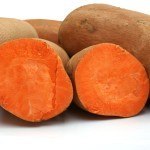 There are about 400 varieties of sweet potatoes. Their flesh may be nearly white, cream, yellow, orange, pink, or purple. They are anti-inflammatory, have antioxidant properties, and they help maintain blood sugar levels.
There are about 400 varieties of sweet potatoes. Their flesh may be nearly white, cream, yellow, orange, pink, or purple. They are anti-inflammatory, have antioxidant properties, and they help maintain blood sugar levels.
The leaves of the sweet potato plant have antioxidant properties and are often added to soups. Purple sweet potatoes contain an antioxidant ability more than 3 times that of blueberries. They are also a very good source of vitamin C, B vitamins, manganese, phosphorus, copper, potassium, and pantothenic acid.
Sweet potatoes can be baked, roasted, stir fried, fried, boiled, or steamed. Like carrots, steaming retains the greatest nutrients, though boiling retains plenty of beta-carotene. Baking or roasting doubles the glycemic index.
Recipe: Sweet Potato Pie
- 4 medium sized sweet potatoes. (The dark orange kind)
- 1 fresh pineapple, chopped into small pieces.
If you bake the sweet potatoes, bake them slowly in a 350 degree oven. If you slice and steam them, you may want to add a little honey after mixing all the ingredients.
- Mash or whip cooked sweet potatoes with coconut oil or ghee
- Add spices to taste: cinnamon, cumin, allspice, nutmeg, and salt.
- Add fresh pineapple when the sweet potatoes have cooled enough to not kill the pineapple’s enzymes.
Onions
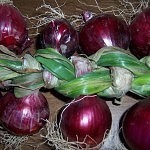 Onions support the cardiovascular system, benefitting both the heart and the blood vessels. They help increase bone density, support ligaments, and are an anti-inflammatory. Onions have also been shown to help prevent cancer and are antibacterial. Rat studies are showing onions help balance blood sugar. They are a very good source of biotin and a good source of vitamin C, copper, B6 and B1, phosphorous, potassium, and folate.
Onions support the cardiovascular system, benefitting both the heart and the blood vessels. They help increase bone density, support ligaments, and are an anti-inflammatory. Onions have also been shown to help prevent cancer and are antibacterial. Rat studies are showing onions help balance blood sugar. They are a very good source of biotin and a good source of vitamin C, copper, B6 and B1, phosphorous, potassium, and folate.
There are two important things to keep in mind when dealing with onions. 1. Do not over peel! The outer layers are more nutrient dense than the inner layers, so peel as little as possible. 2. Let onions sit for 5 minutes after chopping or slicing before cooking them. Again, this has to do with nutrients and the chemical process that takes place within the onion when it is cut.
Green onions can be stored in the refrigerator along with bagged scallions. Other onions should be stored at room temperatures, away from potatoes and bring sunlight. Wire baskets or other methods that allow for ventilation are good.
This amazing recipe comes to us from Julie Kinch and Debbie Fraser of Cooks With Cocktails (See link below).
Recipe: Gluten Free Crispy Baked Onion Rings
Ingredients
- 1 large Sweet Onion (I like Vidalia, but you can really use whatever)
- Olive Oil Spray
For The Dry Mix
- ½ cup Arrowroot Powder
- 2 tsp Paprika
- 5 tsp Salt
- 1 tsp Onion Powder
- 1 tsp Garlic Powder
- 5 tsp Sugar (optional)
For The Wet Mix
Instructions
- Heat your oven to 400 degrees.
- Mix together all the dry ingredients in a medium sized bowl.
- Mix together the two wet ingredients.
- Slice the onion to make rings that are about ¾ of an inch wide. Peel the skin from each ring and carefully separate the rings from each other.
- Line a baking tray with parchment paper.
- One at a time, take each ring and dip it into the wet mix. Then drip it into the dry. Coat it well, but make sure to tap all the excess back into the bowl. Place the ring on the baking tray.
- When all the rings are ready, spray the rings with olive oil spray. You want to coat them, but not get too much. Flip them over and spray the other side.
- Pop them into the oven. Check them after 9 or 10 mins and flip them over. Cook for an additional 4 mins or so.
- Take them out and serve them right away.
Leeks
Like onions and garlic, leeks are an allium vegetable. And like onions and garlic, they should be allowed to sit for 5 minutes or more after cutting before you cook with them in order to receive the greatest nutritional benefit. However, raw leeks are delicious with a milder taste than onions.
Leeks are an excellent source of vitamin K; a very good source of manganese, vitamin B6, copper, iron, and folate; and a good source of vitamin C, vitamin A, fiber, magnesium, vitamin E, calcium, and omega-3 fats.
Leeks provide support for the cardiovascular system due to their antioxidant qualities and their ability to lower homocysteine levels.
Store them in the refrigerator without cutting or washing them before use. To use them, cut off the root and peel the outer layer around the base. You can slice the lower part in whole slices, but as you near the greens you must slice it in half to wash out the dirt that always accumulates.
Cock-a-leekie soup is a delicious traditional Scottish recipe for those who eat chicken.
Add them to any recipe where you would add onions. You can stir fry or steam them, or add them to soups and salads.
Beets
Beets provide antioxidant, anti-inflammatory, and detoxification support. They are especially good for the nervous system and eye health. They help prevent heart disease and cancer, and their fiber is especially healthy for the digestive tract. Beets contain folate, manganese, potassium, copper, magnesium, phosphorus, vitamin C, B6, and iron.
Beets can be eaten raw, baked, roasted, boiled, or steamed, but the most nutritious way to eat them is raw or lightly steamed. (If you cut them into quarters, they should steam within 15 minutes. Cooked beets can be easily peeled after cooking by rubbing the skin off with a paper towel. Nutritious beet greens can be eaten raw or cooked.
To store beets, cut off the tops, leaving 2 inches of stem. Place tops in one plastic bag, the roots in another, and store them both in the refrigerator.
Raw Beet Salad
- Three medium to large beets.
- 2 limes
- Honey to taste
Use a spiralizer to make beet ribbons. Juice the limes. Mix honey into the lime juice to taste. Pour over ribbons. (If you do not have a spiralizer, use a peeler or grate the beets.)
Yams
Yams are also root vegetables, distinctly different from sweet potatoes. Yams, which are native to Africa and Asia, are rarely found in U.S. grocery stores, though they may be found in an Asian market. The peels are brown and are not smooth–rather they look like they are covered in small roots.
There are two main types of sweet potatoes. The one with a deep orange colored flesh is often called a yam, just to differentiate the two.
True yams are a good source of potassium, vitamin C, and vitamin B6. As far as recipes go, you can cook yams like a sweet potato but know that they are drier and not as sweet. Try yams in place of the sweet potatoes for these fries:
Radishes
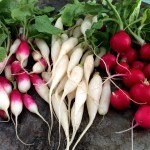 The health benefits of radishes are truly impressive. They are said to be good for the liver and stomach, the kidneys and bladder, the lungs, the cardiovascular system and the immune system. They purify the blood and eliminate waste, detoxify and are an anti-congestive. They are used to treat cancer, jaundice, constipation, urinary tract and kidney infections, skin ailments, and more.
The health benefits of radishes are truly impressive. They are said to be good for the liver and stomach, the kidneys and bladder, the lungs, the cardiovascular system and the immune system. They purify the blood and eliminate waste, detoxify and are an anti-congestive. They are used to treat cancer, jaundice, constipation, urinary tract and kidney infections, skin ailments, and more.
Radishes come in varying shapes and sizes from large to small, from long to round, and in colors that include white, black, yellow, green, pink, red, or purple. All are a great source of vitamin C.
Daikon radishes come in all shapes and sizes, though the ones sold in the U.S. market generally look like oversized white carrots. The tops are edible and have a peppery taste; they are often added to salads.
Smaller radishes are more nutritious because nutrition is pulled from the root to the tops as the vegetable matures.
Daikons are an excellent source of vitamin C. They also contain vitamin B6, magnesium, and calcium.
To store, wrap tightly in plastic and refrigerate.
Grate them raw and add to salads, slow cook, steam, roast, bake, or pickle them. You can frequently find a daikon radish salad made with rice vinegar in Asian buffets. But here is a recipe for a real treat:
Recipe: Spicy Radish Kimchi
From Reviving the Tradition of Fermented Foods (See link below)
Yield: 1 quart
Ingredients
- 1 large (12-16″ and 3″ diameter) daikon radish
- 2 baby leeks OR 4 scallions (green onions)
- filtered water
- sea salt
- 4-6 garlic cloves, peeled
- 2-inch piece of ginger
- 1 oz. red pepper powder (more=spicier)
- 1 Tbsp fish sauce (to taste); optional
- 1 Tbsp tamari or shoyu (soy) sauce
Instructions
- Soak the Veg
- Cut off greens from radish and peel outer layer off with a peeler. Use greens for another purpose.
- Cut radish into 1 inch cubes, or slice into rings.
- Dissolve 3 Tablespoons salt into 1 quart of water in a half-gallon (or larger) container. Avoid using a metal container.
- Add radish cubes to brine and soak for up to 6 hours.
- Drain the veggies through a colander. Reserve 1 pint of brine when draining.
- Make Paste
- Roughly chop the garlic and ginger. Add to bowl of a food processor bowl. If you don’t have a food processor, dice the ginger and garlic so it’s almost a paste, and add to a mixing bowl.
- Slice leeks or scallions into ½” pieces and add to mix.
- Add pepper powder, tamari and fish sauce to mixing bowl. Vegan variation: omit fish sauce.
- Stir and mash contents (or pulse with food processor) together until a paste forms.
- Wearing a latex or plastic glove to protect yourself from the heat of the pepper, mix the paste thoroughly with your hand into the drained radish cubes. You can mix everything directly in the fermenting container, or in a separate large mixing bowl. Mix until the cubes are coated nicely with the paste.
- Ferment
- Even out the cubes in the container. Next, right on top of the mixture, place the largest object (usually a plastic lid or plate) you can find which will fit inside the diameter of the container.
- Add a weight (such as a wine bottle or other glass bottle) on top of the lid/cover.
- Liquid will continue to create a brine while the veggies are weighed down.
- Check the container in 1 day. If the contents are not sumberged in brine, add the reserved brine.
- Cover with a cloth and rubber band to keep flies out. (If using airlock skip this step).
- Place in a cool spot (out of direct light) for 14 days. The larger pieces take a little longer to ferment than smaller diced styles of kimchi. Note: Your house will smell like kimchi.
- Move to refrigerator, where the taste will develop slowly. Will keep for up to 6 months
Turnips
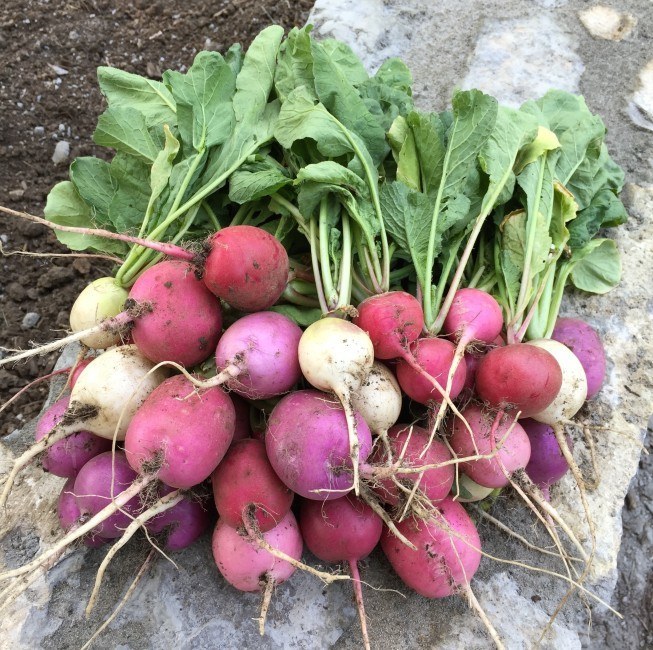
Turnips are an ancient food for humans. Evidence shows they have been eaten since prehistoric times. They have also been used as fodder for animals for 600 years or more.
Turnips are a good source of vitamin C, while the greens (the tops) are a good source of vitamin C, vitamin K, vitamin A, folate, and calcium.
Some people find turnips too bitter to eat due to a genetic sensitivity to the cyanoglucosides they contain.
Turnips can be eaten raw – just grate them up and add them to salads. Generally, they are eaten in the many ways we eat potatoes. You can boil them, fry them, steam them, mash them up with milk and butter or add them to soups, stews, and other dishes.
Rutabagas
The origin of the rutabaga is an interesting one: they are a cross between the turnip and cabbage. In many countries they are called turnips, yellow turnips, or Swedish turnips along with other names such as neeps.
Rutabagas are an excellent source of vitamin C.
Like turnips, rutabagas contain cyanoglucosides. To those who have inherited 2 genes that detect a particular bitterness receptor, rutabagas are inedible due to their bitterness.
Rutabagas are eaten in a variety of ways. They can be baked or boiled and eaten alone or mashed and combined with other root vegetables such as potatoes and carrots. Rutabagas are also added to soups and stews.
Parsnips
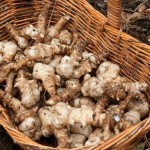 Parsnips look like white carrots. Like turnips, they were once used as a regular staple before the popularity of potatoes took their place.
Parsnips look like white carrots. Like turnips, they were once used as a regular staple before the popularity of potatoes took their place.
Parsnips are a good source of vitamin C, folate, and manganese. You can cook them any number of ways from grating them and adding them to salads raw to using them instead of carrots in a cake.
Below you will find two recipes; one is sweet, the other not. These recipes are from Seasonal Chef. (See link below).
Recipe: Orange-Glazed Parsnips
- 8-10 medium parsnips
- 1 tsp salt
- 2 tbl butter or margarine
- 2 tbl honey
- 1/2 tsp salt
- 1/4 cup orange juice
- 1/2 tsp grated orange peel
Instructions
- Peel parsnips and cut into quarter-inch-thick sticks. Cover parsnips with water and simmer until just tender, about 15 minutes. Drain.
- Meanwhile, in saucepan, melt butter, stir in honey, salt, orange juice and peel. Heat to boiling. Turn off heat, add drained parsnips and gently stir to coat pieces.
NOTE: For maple-glazed variation, try using ¼ cup maple syrup, ¼ tsp prepared mustard, salt and pepper to taste.
Recipe: Kale and Parsnips
Ingredients
- 1 cup sliced onions
- 1 cup halved and sliced parsnips
- 1 tbl corn oil
- 1 cup water
- 2 tbl ginger, minced
- 1 bunch kale, veins removed and cut into bite-sized pieces
Instructions
- Saute the onions and parsnips in oil for about 5 minutes, stirring occasionally to prevent burning. Add the water and ginger. Cover and simmer for 4 to 5 minutes.
- Add the kale and continue cooking 4 to 5 minutes longer. Stir occasionally but otherwise keep the saucepan covered.
Jerusalem artichokes
 Jerusalem artichokes, also known as sunchokes, are a plant native to North America that was cultivated by Native Americans. The plant is in the sunflower family, and it grows tall beautiful sunflowers. The root is similar to ginger root or fingerling potatoes.
Jerusalem artichokes, also known as sunchokes, are a plant native to North America that was cultivated by Native Americans. The plant is in the sunflower family, and it grows tall beautiful sunflowers. The root is similar to ginger root or fingerling potatoes.
The skin of the sunchoke root may be light brown to tan or pink to reddish in color. The inside may be white, cream colored, tan, or purple. They are high in fiber and a good source of iron, potassium, and thiamin.
There are many recipes, various kinds, for sunchokes, from soup to chips. As a matter of fact, there are many recipes on the web for chips. Just slice them thin and cook in oil. Sprinkle with herbs. But be careful, they’re apparently delicious. Don’t eat too many. Sunchokes have quite a reputation for flatulence when eaten in excess.
The following recipe is from The Fruit Guys. (See link below.)
Recipe: Pan-Fried Jerusalem Artichokes in Sage Butter
Ingredients
- 3 tablespoons butter, divided
- 2 tablespoons olive oil
- 1 pound Jerusalem artichokes, scrubbed and cut into 1/4-inch-thick rounds
- 3 tablespoons fresh sage leaves, coarsely torn and divided
- 2 teaspoons fresh lemon juice
- 2 tablespoons fresh Italian parsley, chopped
Preparation
- Melt 1 tablespoon butter with olive oil in large nonstick skillet over medium-high heat.
- Add Jerusalem artichokes and half of the sage.
- Sprinkle with salt and pepper. Sauté until brown and just beginning to soften, turning frequently, about 10 minutes.
- Using slotted spoon, transfer Jerusalem artichokes to shallow serving bowl.
- Add remaining 2 tablespoons butter and sage to skillet; fry until sage darkens and begins to crisp, about 30 seconds.
- Add lemon juice; simmer 1 minute. Pour lemon-sage butter over Jerusalem artichokes in bowl, tossing to coat.
- Season with salt and pepper. Sprinkle with parsley.
- Serves 4–5. Prep time, 15 minutes; cook time, 15 minutes.
Celeriac
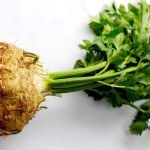 Also known as celery root, turnip rooted celery, or knob celery, is a variety of celery. Celeriac is an excellent source of vitamin K and a good source of vitamin C, Vitamin B6, and phosphorus. The big brown bulbous root is eaten raw or cooked and tastes similar to celery, or some say, celery and parsley combined.
Also known as celery root, turnip rooted celery, or knob celery, is a variety of celery. Celeriac is an excellent source of vitamin K and a good source of vitamin C, Vitamin B6, and phosphorus. The big brown bulbous root is eaten raw or cooked and tastes similar to celery, or some say, celery and parsley combined.
The following recipe is from Sylvia Fountaine of Feasting at Home. (See link below.)
Recipe Celeriac Fennel Soup
Prep time, 15 mins. Cook time is about 20 mins. The recipe yields 8 Cups Soup
Ingredients
- 1 large fennel bulb, cored and diced ( about 1 ½ cups)
- 1 C white onion, diced
- 1-2 Tablespoons olive oil
- 2 grapefruit-sized celeriac- peeled and diced ( about 4-5 cups)
- 8 Cups Chicken or Veggie stock
- ¼ teaspoon white pepper
- salt to taste
- ¼ cup creme fraise or sour cream for garnish ( optional)
- Parsley oil (optional, for garnish – see recipe below)
Instructions
In a large heavy bottom pot, saute diced onion in 1-2 Tablespoons olive oil, over medium high heat until tender, about 5 minutes. Add fennel. Turn heat to medium-low and saute until fennel begins to caramelize, stirring occasionally about 12 minutes. Add celeriac, pepper and 8 cups chicken stock. Turn heat to high, bring to a simmer, lower heat, cover, and continue simmering until celeriac is very tender, about 15-20 minutes.
Using a blender, blend until smooth -in batches, only filling blender 1/2 full. (Remember when blending any hot liquid, cover the blender lid firmly with a kitchen town, and only fill blender 1/2 full, and start on the lowest speed, to prevent a blender explosion.)
Return to the pot. Taste for salt. When serving, garnish with a swirl of creme fraise, (or sour cream) and a little parsley oil.
Recipe Parsley Oil
- 1 Cup packed Italian parsley ( stems ok)
- ½ Cup olive oil
- ½ clove garlic
- ¼ teaspoon kosher salt
- 2 teaspoon lemon juice
- Pulse all ingredients in a blender or food processor until combined.
- 1 white onion diced
Kohlrabi
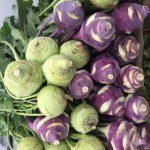 You know how tomatoes are actually fruits? Kohlrabi isn’t actually a root vegetable. The bulb is actually a part of the stem that grows above ground. It is probably considered a root vegetable due to both its name and its appearance, as it looks like a cross between a turnip and celeriac, and its name is a German word that is literally a combination of cabbage and turnip.
You know how tomatoes are actually fruits? Kohlrabi isn’t actually a root vegetable. The bulb is actually a part of the stem that grows above ground. It is probably considered a root vegetable due to both its name and its appearance, as it looks like a cross between a turnip and celeriac, and its name is a German word that is literally a combination of cabbage and turnip.
Kohlrabi is a member of the cabbage family, though it is said that its mild taste is more like broccoli. This vegetable, once a favorite of European nobles, has never lost its popularity in Europe.
It is high in fiber, vitamin A, vitamin C, folic acid and calcium.
It can be eaten raw, as a matter of fact, it is eaten raw like a piece of fruit by many Germans. Choose small bulbs; large bulbs are woody, tough, and require peeling. Small bulbs can be eaten peel and all.
There are two varieties: one is purple, the other green. The purple one is sweeter.
Here is an interesting salad from Vegetarians in Paradise. (See link below.)
Kohlrabi Siam Chopped Salad
Yields 4 servings
Ingredients
- 4 medium kohlrabis, peeled and cut into 1/4-inch dice
- 1 1/2 cups (360 ml) chopped Napa cabbage
- 1/4 pound (115g) snow peas, chopped
- 1/2 to 1 fresh pasilla (poblano) pepper, diced or 1/8 teaspoon crushed red pepper flakes
- 1/2 red bell pepper, cut into fine julienne about 1 inch (2.5 cm) long
- 3 green onions, chopped
- 3 tablespoons organic canola oil
- 2 tablespoons toasted sesame seeds
- 1 or 2 cloves garlic, finely minced
- 1/2 inch (1 cm) piece ginger, peeled and grated
- Juice of 1/2 lemon (about 1 tablespoon)
- 2 teaspoons sesame oil
- Dash of rice vinegar
- Salt and freshly ground pepper to taste
- Black sesame seeds
- 2 tablespoons minced green onions
Instructions
Combine all the ingredients, except the black sesame seeds and green onions, in a large bowl and toss well to distribute the seasonings evenly.
Transfer to an attractive serving bowl or platter and garnish the top with the black sesame seeds and minced green onions.
This salad is best if made several hours ahead to allow the dressing to penetrate the vegetables. Serve as a salad course or a side dish.
Cassava or Yuca
Cassava, also known as Yuca, maniac, Brazilian arrowroot, tapioca, and many other names, is an important staple throughout the world. Yuca has a high carbohydrate content and is high in vitamin C, phosphorus, and calcium. An amazing variety of traditional dishes are based on this root vegetable from alcoholic drinks to a vegetable used like potatoes or flour to make bread, cakes, and crackers. In the U.S. cassava is mostly sold as tapioca for pudding.
Cassava is a rot generally 2-4 inches in diameter at the top and approximately 6-12 inches long. The brown skin is rough; the inner flesh is white to yellow. Cassava is an excellent source of calcium, vitamin C. The leaves are edible as well and are a good source of protein.
Cassava root must be properly prepared or it will be toxic.
Tapioca Pudding
- 3 cups of goat milk or nut milk
- 2 eggs – whisked
- ½ cup tapioca
- ¼ teaspoon salt
- ½ teaspoon vanilla
- ¼ to ½ cup (more or less to taste) of honey
Instructions
Soak tapioca in cold water overnight.
Drain tapioca and add to milk and salt in a saucepan. Bring to a boil while stirring.
Reduce heat and cook for 5 minutes. Continue to stir.
Remove from heat. Whisk a cup of mixture into beaten eggs, a little at a time. Once it is all blended, stir it back into the pot.
Simmer over medium-low heat for 2 or more minutes, until it thickens. Remove from heat and add honey and vanilla. Stir and taste. Add more honey if needed.
Serve hot or refrigerate and serve cold.
Jicama
Jicama, also called Mexican yam or Mexican turnip (among other names), is actually a relative of the bean family. Like regular potatoes, the vines and leaves of this plant are poisonous.
Jicama is a good source of fiber and an excellent source of vitamin C.
The flesh is white with a papery yellow/brown peel. The sweet, crunchy flesh is often cooked in soups and stir fries, but it usually eaten raw with a dip.
An easy dip is made by adding a bit of honey and lime juice to yogurt. But any dip you use for raw veggies is a good match for jicama from spinach and guacamole to the hummus and gourmet combinations. Many just squirt lime and sprinkle chili powder on jicama strips. Here is a great recipe that utilizes the dehydrator.
Makes 4 servings
Ingredients
- 2 medium jicama
- 2 tbs gluten-free tamari
- 1 tbs + 1tsp agave
- juice of 2 limes
- 1/2 tsp cayenne pepper
Directions
Combine tamari, agave, lime juice and cayenne pepper together in a small bowl.
Peel jicama and cut it in half. Slice into strips 1/8″-1/4″ thick. You can do this by hand or with a mandolin slicer.
Place jicama strips in a medium bowl and coat thoroughly with marinade. Make sure each piece of jicama is completely covered.
Place strips on dehydrator tray. Dehydrate at 110° for 4 hours, then flip jicama over, rotate trays and dehydrate for another 4-6 hours. Your chips are done when they are crispy on the outside but not shriveled. Enjoy with salsa, guacamole or your favorite dip!
Maca Root
Maca root is also known as Peruvian ginseng. It’s not surprising, considering the medicinal properties attributed to it and the fact that it is known to be an aphrodisiac. It is eaten as a food in the areas where it is grown and it made into flour. But most of its use in the U.S. is as a supplement.
Maca root is said to increase energy; boost brain power, endurance (both athletic and sexual), stamina, libido, fertility, and general health. It balances hormones (both male and female), reduces stress and anxiety. It stabilizes mood and mood swings, aiding in depression. It improves health of teeth and bones, strengthens hair and reduces hair loss. It alleviates symptoms of menopause and PMS. It is also said to clear acne and blemishes. Wounds heal faster.
Maca is rich in B vitamins, vitamin C, vitamin E, calcium, zinc, iron. Magnesium, phosphorus, and amino acids.
The hypocotyl, the bulb between the stem and actual roots, can be one of many colors: cream, gold, red, green, blue, purple, or black.
Maca Root Contraindications
- Do not use if pregnant or lactating.
- Do not use if you have hormone-related cancer or polycystic ovary syndrome.
- Use with caution if you have thyroid problems. Lighter colored maca inhibits iodine uptake, while darker maca contains natural iodine.
There are also warnings to start slow, with no more than ½ to 1 teaspoon a day; 1 tablespoon is the average daily dose for a few days followed by a few days abstinence. Too much may disrupt your hormones.
These are most of the better-known root vegetables. There are more, of course, some familiar, many not, but all are worth discovery. If you have any favorite recipes, please share them.
Further Reading:
Recommended Supplements:
Sources:
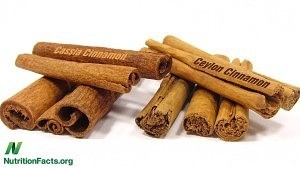




 The health benefits of radishes are truly impressive. They are said to be good for the liver and stomach, the kidneys and bladder, the lungs, the cardiovascular system and the immune system. They purify the blood and eliminate waste, detoxify and are an anti-congestive. They are used to treat cancer, jaundice, constipation, urinary tract and kidney infections, skin ailments, and more.
The health benefits of radishes are truly impressive. They are said to be good for the liver and stomach, the kidneys and bladder, the lungs, the cardiovascular system and the immune system. They purify the blood and eliminate waste, detoxify and are an anti-congestive. They are used to treat cancer, jaundice, constipation, urinary tract and kidney infections, skin ailments, and more.


 You know how tomatoes are actually fruits? Kohlrabi isn’t actually a root vegetable. The bulb is actually a part of the stem that grows above ground. It is probably considered a root vegetable due to both its name and its appearance, as it looks like a cross between a turnip and celeriac, and its name is a German word that is literally a combination of cabbage and turnip.
You know how tomatoes are actually fruits? Kohlrabi isn’t actually a root vegetable. The bulb is actually a part of the stem that grows above ground. It is probably considered a root vegetable due to both its name and its appearance, as it looks like a cross between a turnip and celeriac, and its name is a German word that is literally a combination of cabbage and turnip.